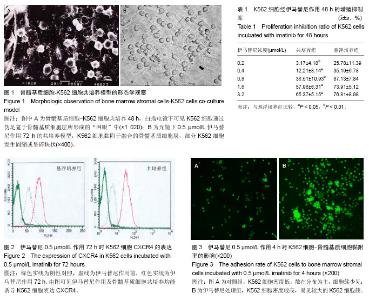| [1] Jabbour E, Kantarjian H.Chronic myeloid leukemia: 2014 update on diagnosis, monitoring, and management.Am J Hematol. 2014;89(5):547-556.
[2] Waller CF.Imatinib mesylate.Recent Results Cancer Res. 2014; 201:1-25.
[3] Castagnetti F, Palandri F, Amabile M,et al.Results of high-dose imatinib mesylate in intermediate Sokal risk chronic myeloid leukemia patients in early chronic phase: a phase 2 trial of the GIMEMA CML Working Party.Blood. 2009;113(15): 3428-3434.
[4] Lee F, Fandi A, Voi M.Overcoming kinase resistance in chronic myeloid leukemia.Int J Biochem Cell Biol. 2008;40(3): 334-343.
[5] Weisberg E, Liu Q, Zhang X,et al.Selective Akt inhibitors synergize with tyrosine kinase inhibitors and effectively override stroma-associated cytoprotection of mutant FLT3-positive AML cells.PLoS One. 2013;8(2):e56473.
[6] Anderson KC.Targeted therapy of multiple myeloma based upon tumor-microenvironmental interactions.Exp Hematol. 2007;35(4 Suppl 1):155-162.
[7] Schraufstatter IU, Discipio RG, Khaldoyanidi S.Mesenchymal stem cells and their microenvironment.Front Biosci (Landmark Ed). 2011;16:2271-2288.
[8] Tabe Y, Konopleva M.Advances in understanding the leukaemia microenvironment.Br J Haematol. 2014;164(6): 767-778.
[9] 王吉刚,陈幸华,周凡,等.TRAIL逆转基质细胞黏附介导Jurkat细胞耐药的研究[J].中华肿瘤防治杂志,2009,16(8):621-624,632.
[10] 赵兴海,孙京杰,刘爱武,等.丙戊酸钠调节组蛋白乙酰化抑制胃癌细胞增殖的实验研究[J].中华肿瘤防治杂志,2009,16(8): 587-591.
[11] Jacamo R, Chen Y, Wang Z,et al.Reciprocal leukemia-stroma VCAM-1/VLA-4-dependent activation of NF-κB mediates chemoresistance.Blood. 2014 4;123(17):2691-2702.
[12] Bewry NN, Nair RR, Emmons MF,et al.Stat3 contributes to resistance toward BCR-ABL inhibitors in a bone marrow microenvironment model of drug resistance.Mol Cancer Ther. 2008;7(10):3169-3175.
[13] 刘志,刘晓力,杜庆锋,等.纤维连接蛋白黏附共培养对伊马替尼诱导K562细胞凋亡影响的研究[J].中华血液学杂志,2009,30(12): 839-840.
[14] Seke Etet PF, Vecchio L, Nwabo Kamdje AH.Signaling pathways in chronic myeloid leukemia and leukemic stem cell maintenance: key role of stromal microenvironment.Cell Signal. 2012;24(9):1883-1888.
[15] Azizidoost S, Babashah S, Rahim F,et al.Bone marrow neoplastic niche in leukemia.Hematology. 2014;19(4):232-238.
[16] Lundell BI, McCarthy JB, Kovach NL,et al. Activation- dependent alpha5beta1 integrin-mediated adhesion to fibronectin decreases proliferation of chronic myelogenous leukemia progenitors and K562 cells.Blood. 1996; 87(6): 2450-2458.
[17] Zhang B, Li M, McDonald T,et al.Microenvironmental protection of CML stem and progenitor cells from tyrosine kinase inhibitors through N-cadherin and Wnt-β-catenin signaling.Blood. 2013;121(10):1824-1838.
[18] Krause DS, Lazarides K, Lewis JB,et al.Selectins and their ligands are required for homing and engraftment of BCR-ABL1+ leukemic stem cells in the bone marrow niche. Blood. 2014;123(9):1361-1371.
[19] Martín-Henao GA, Quiroga R, Sureda A,et al. L-selectin expression is low on CD34+ cells from patients with chronic myeloid leukemia and interferon-a up-regulates this expression. Haematologica. 2000;85(2):139-146.
[20] Peled A, Tavor S. Role of CXCR4 in the pathogenesis of acute myeloid leukemia. Theranostics. 2013;3(1):34-39.
[21] Sison EA, McIntyre E, Magoon D, et al. Dynamic chemotherapy-induced upregulation of CXCR4 expression: a mechanism of therapeutic resistance in pediatric AML. Mol Cancer Res. 2013;11(9):1004-1016. |

